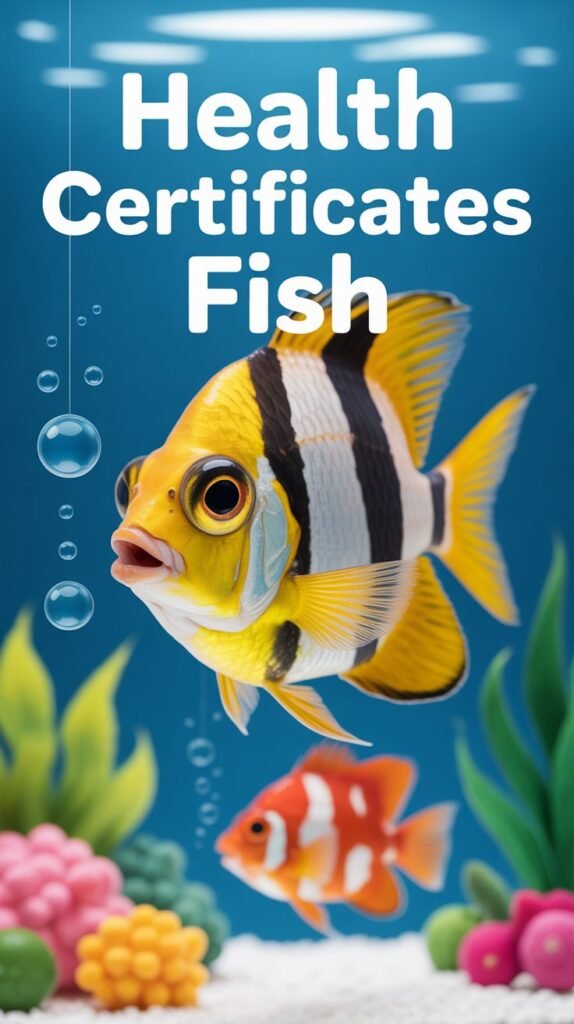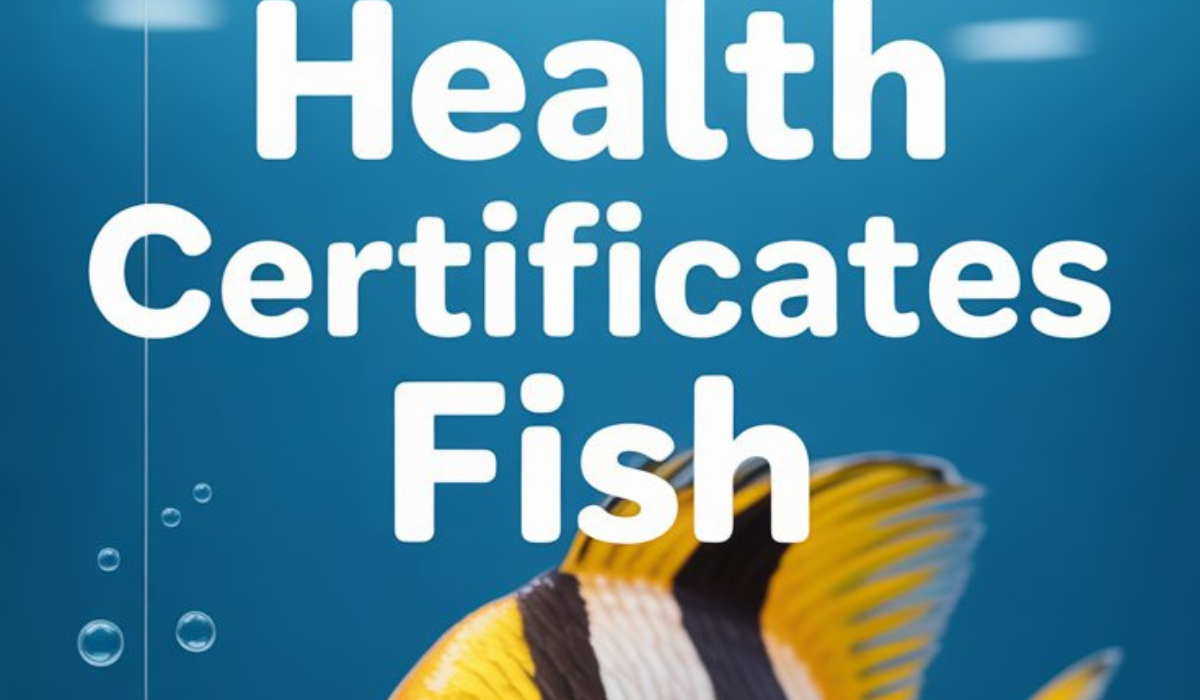Ensuring the health and safety of live fish during transportation, trade, and breeding programs is essential in today’s aquaculture and aquarium industries. One of the most critical documents required in this process is the Health Certificate for Fish. Whether you are an aquarium hobbyist, a fish breeder, a commercial importer, or part of a large aquaculture facility, understanding how health certificates work can directly impact your success, compliance, and animal welfare standards.
In this comprehensive guide, we break down everything you need to know about health certificates for fish—including what they are, why they’re needed, how to obtain them, global regulations, and best practices for disease-free fish transportation.
What Are Health Certificates for Fish?
A health certificate for fish is an official document issued by a licensed veterinarian or authorized aquatic health specialist confirming that the fish being transported or sold are disease-free and meet the health standards required by the receiving country, state, or organization.
These certificates typically confirm:
- The fish are inspected and appear healthy
- There is no sign of infectious or parasitic diseases
- The stock originates from a certified disease-free facility
- Proper diagnostic tests were performed
- The shipment complies with government or international regulations
Health certificates play a key role in preventing the spread of aquatic diseases across borders, protecting native ecosystems, and supporting responsible fish trade.
Why Are Health Certificates Required for Fish?

There are several major reasons why a health certificate is mandatory in many cases:
1. Preventing Disease Transmission
Fish diseases—such as Ichthyophthirius (Ich), KHV (Koi Herpes Virus), Columnaris, or Mycobacterium—can spread rapidly and cause massive losses. A health certificate ensures that transported fish do not carry harmful pathogens.
2. Protecting Native Ecosystems
Introducing diseased fish into natural waterways or unregulated aquaculture systems can disrupt entire ecosystems. Governments enforce certification to prevent invasive pathogens.
3. Complying With Import and Export Regulations
Most countries require fish shipments to be accompanied by an official health certificate. Shipments without proper documentation can be rejected, destroyed, or quarantined at the importer’s expense.
4. Ensuring High-Quality Trade Standards
For breeders and exporters, certificates increase credibility, boost customer confidence, and support the trade of premium fish.
5. Safeguarding Aquaculture Industries
Many nations rely on aquaculture as a major food supply. Health certificates protect farms from costly disease outbreaks.
When Are Health Certificates for Fish Needed?
Health certificates are required in a wide range of situations:
- Importing or exporting live fish
- Shipping fish across state or provincial borders
- Transferring fish to public aquariums, zoos, or research centers
- Large-scale breeding operations
- Selling fish to retailers
- Participation in aquaculture trade shows or competitions
Even small-scale hobbyists may need health certificates when transporting rare or valuable species internationally, such as koi, goldfish, or ornamental tropical fish.
Types of Fish Covered Under Health Certification
Health certificates may cover:
1. Aquarium Fish
- Guppies
- Tetras
- Bettas
- Cichlids
- Goldfish
- Koi
2. Aquaculture Species
- Tilapia
- Carp
- Salmon
- Catfish
- Shrimp (aquatic invertebrates often require similar documentation)
3. Wild-Caught Species
These need certification to ensure they are free from parasites or environmental diseases.
What Does a Fish Health Certificate Include?
A proper fish health certificate usually contains:
- Issuing authority (veterinarian or aquatic biologist)
- Date and location of inspection
- Species and number of fish
- Origin of the fish (farm, breeder, or exporter)
- Health test results
- Disease history of the facility
- Water quality analysis (optional)
- Certification statement confirming disease-free status
- Signatures and official stamps
Different countries may require additional details such as vaccination records (where applicable) or specific diagnostic testing.
How to Obtain a Health Certificate for Fish

Obtaining a health certificate involves several steps:
1. Contact a Certified Aquatic Veterinarian
Only an authorized aquatic health inspector or veterinarian can issue a legal certificate.
2. Schedule an Inspection
The specialist will examine:
- Fish behavior
- Physical health (fins, scales, gills)
- Water parameters
- Facility hygiene
3. Conduct Diagnostic Testing
Lab tests may include:
- PCR tests (for viral diseases)
- Bacterial cultures
- Parasite examination
- Skin or gill scrapings
4. Facility Certification (Optional)
Some exporters maintain long-term disease-free certification for their farms.
5. Issuance of the Certificate
Once tests are clear, the authority issues the health certificate which accompanies the shipment.
Disease Testing Requirements for Health Certificates
Different countries specify various mandatory disease tests. Common diseases screened for include:
- Koi Herpes Virus (KHV)
- Viral Hemorrhagic Septicemia (VHS)
- Spring Viremia of Carp (SVC)
- Aeromonas hydrophila infections
- Ich (Ichthyophthirius multifiliis)
- Flukes and parasitic worms
Testing ensures that fish do not spread these infections across borders.
International Regulations for Fish Health Certificates
Various organizations regulate fish health globally:
1. OIE (World Organisation for Animal Health)
Creates international fish health standards and disease surveillance guidelines.
2. CITES
Protects endangered aquatic species and requires special permits.
3. Country-Specific Regulations
Each country may have its own import rules, such as:
- United States Fish & Wildlife Service (USFWS)
- USDA-APHIS
- European Union Animal Health Law
- UK DEFRA regulations
- Asian import/export quarantine protocols
Understanding the specific requirements of the recipient country is crucial before shipping fish.
The Role of Quarantine in Health Certification
Before certification, most fish must undergo a quarantine period:
Why Quarantine Is Necessary
- Allows observation of symptoms
- Reduces stress before transport
- Prevents hidden infections
- Gives time for testing and labs
Typical Quarantine Duration
- 2 to 4 weeks depending on species and regulations
Quarantine Facility Requirements
- Separate filtration system
- Stable water parameters
- Disinfection and biosecurity protocols
- Daily monitoring records
Benefits of Health Certificates for Breeders and Importers
Health certificates offer numerous advantages:
1. Increased Buyer Trust
Customers prefer fish from certified disease-free facilities.
2. Access to International Markets
Certificates are required for entry into many countries.
3. Reduced Mortality in Transit
Healthy fish handle shipping stress better.
4. Legal Protection
Proper documentation avoids fines, shipment rejection, or legal complications.
5. Higher Prices for Certified Fish
Buyers pay more for guaranteed healthy fish.
Common Challenges in Obtaining a Fish Health Certificate
While beneficial, the certification process can present challenges:
1. Cost of Testing
Lab diagnostics may be expensive for small-scale breeders.
2. Limited Availability of Aquatic Vets
Not all regions have trained fish health inspectors.
3. Strict Government Regulations
Some countries require extensive documentation.
4. Time Constraints
Quarantine and testing take time, delaying shipments.
5. Temperature and Transport Stress
Fish must remain healthy throughout inspections.
How to Prepare Fish for Certification and Transport
1. Improve Water Quality
Healthy fish come from clean, stable environments.
2. Reduce Stress Before Inspection
Avoid overfeeding or netting fish unnecessarily.
3. Maintain Optimal Diet
A nutrient-rich diet boosts immunity.
4. Follow Strict Biosecurity Protocols
Disinfect tanks, tools, and equipment regularly.
5. Keep Detailed Records
Logs help vets understand past treatments and conditions.
Best Practices for Disease-Free Fish Shipments
- Use oxygenated bags or specialized transport containers
- Maintain stable temperature using heat packs or coolers
- Avoid overcrowding
- Use clean, conditioned water
- Ship during favorable weather conditions
- Inspect fish again before packing
These steps complement the health certificate and ensure safe arrival.
FAQs About Health Certificates for Fish
1. What is a fish health certificate?
It is an official document confirming that fish are disease-free and safe for transport or sale.
2. Who can issue a fish health certificate?
A licensed aquatic veterinarian or authorized health inspector.
3. Do aquarium fish need health certificates?
Yes, especially when shipped internationally or in large quantities.
4. How long is a fish health certificate valid?
Typically 10–30 days, depending on the regulations.
5. Can hobbyists obtain health certificates?
Yes, hobbyists transporting fish across borders may need one.
6. Do all countries require the same health tests?
No, each country has unique requirements and disease screenings.
7. Are quarantine periods mandatory for certification?
In most cases, yes. Quarantine ensures the fish show no signs of disease.
8. How much does a fish health certificate cost?
Costs vary depending on the vet fees and number of diagnostic tests.
9. Can a shipment be rejected without a health certificate?
Yes, customs authorities can reject, quarantine, or destroy uncertified shipments.
10. Do domestic shipments require certificates?
Some states or regions require certification, especially for commercial sales.

